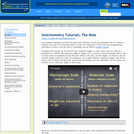
Learning modules that describe how to convert between number of molecules, moles and mass, for students in General Chemistry.
- Subject:
- Physical Science
- Material Type:
- Module
- Date Added:
- 07/20/2016

Learning modules that describe how to convert between number of molecules, moles and mass, for students in General Chemistry.

You probably remember the mole from high school chemistry, but do you remember why it is useful to chemists? The goal of the following video is to give the "big picture" of the mole and its applications; information on how to use the mole in calculations can be found in another tutorial. Throughout this course, we will use the term "molecular weight" to refer to the mass of a mole of a substance (for instance, the molecular weight of oxygen (O2) is 32 g/mol). Recent textbooks refer to this as "molar mass" to emphasize (i) that this term refers to the mass, not the weight, of substance, and (ii) that the quantity refers to a mole of a substance, not a single molecule. "Molecular weight" may be less precise, but it remains the term that most practicing chemists use in the laboratory. For this reason, we continue to use "molecular weight" in this course.

This module has two parts:1- Introduction to the concept of a "mole" and Avogadro's number.2- Application of the Mole (Avogadro's number) as a conversion factor relating mass in grams to number of atoms or molecules (formula unit for ionic compounds)

Chemists need stoichiometry to make the scale of chemistry more understandable - Hank is here to explain why and to teach us how to use it.
Chapters:
Atomic Mass Units
Moles
Molar Mass
Equation Balancing
Molar Ratios